One of the best arguments for protecting the San Tin fish ponds area – rather than destroying a large area to build the San Tin Technopole – should be mitigating flooding risk, including in downtown Shenzhen, which is also on the Shenzhen River floodplain.
Yes, the Shenzhen River and more have been turned into giant drainage type channels (Shenzhen River Regulation Project); but that is not an adequate, sustainable solution, as events in September 2023 show: for instance:
All schools, some subway stations and offices in the Guangdong city of Shenzhen were shut on Friday.
Residents holding onto safety lines stepped gingerly through knee-deep water in Shenzhen, videos from state media showed.
[[Note that Shenzhen floods affect downtown areas like Luohu, which is on the Shenzhen River floodplain]]
Hong Kong, Shenzhen deluged by heaviest rain on record
Floodplain restoration is proving effective elsewhere; see a study here (more links below; searching online reveals a whole lot more information):
We conclude that projects that both reduce flood risk and restore ecosystems are clearly possible and often cost-effective, and that they could be more widely implemented. The principal barriers are often institutional and regulatory, rather than technical.
Restoring Rivers and Floodplains for Habitat and Flood Risk Reduction: Experiences in Multi-Benefit Floodplain Management From California and Germany
Fanciful idea for a wetland park with multiple benefits including reducing flooding risk
Suppose instead of development, a wetland was established – partly by demolishing bunds, interlinking ponds and even creating large ponds or lakes – and this had a total area of 500ha, with the ability to reduce water level by at least a metre at low tide, via sluice gate[s] to Shenzhen River, in turn emptying into Deep Bay and thence the Pearl River Delta. This would have a capacity of at least 5 million cubic metres [as floodwaters could be channelled pumped in to raise the level by metre or more]; far bigger than the CEDD’s planned underground water storage facility with a capacity of 200,000 cubic metres.
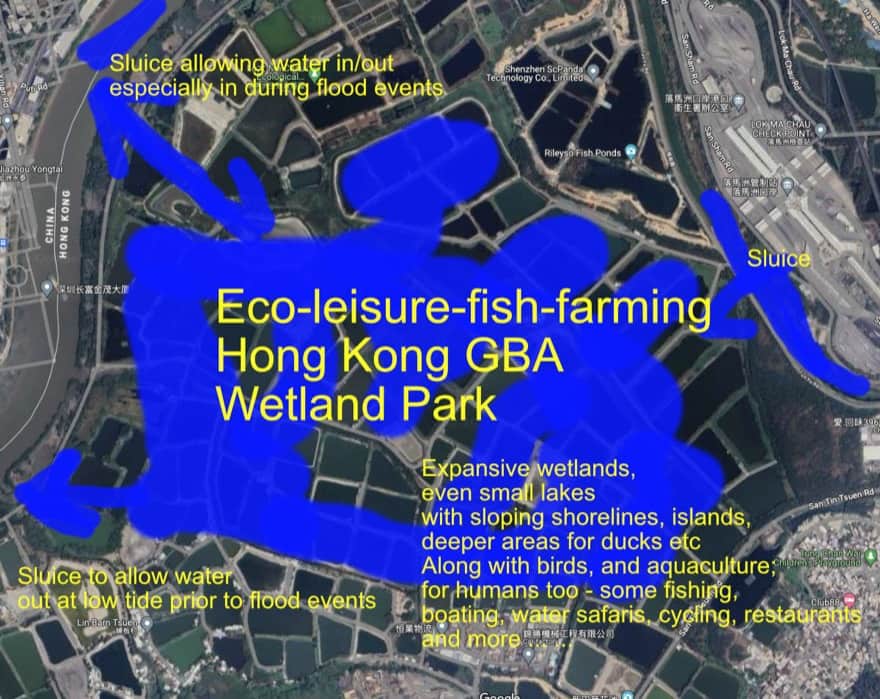
Map of the wetland park/floodplain restoration area here; as you can see extremely detailed… …
Yes, this idea is fanciful; yet I’m not sure why I haven’t seen more about this from green groups and others.
LOTS more results if google for river flooding floodplain restoration; it’s not a new, untested idea. There’s even a lake along Shenzhen River supposed to have this function; evidently too puny.
And yes, such a wetland park in HK would not be enough for the biggest floods, and would be overwhelmed by storm surge. But could help at times.
Instead, building on floodplain seems just cavalier…
Experts: Wetlands key to climate-resilient Northern Metropolis
There’s no need to just take my word for ways the Deep Bay wetlands are vital for even urban development in northwest Hong Kong and Shenzhen. See, for instance, this opinion piece by three leading Hong Kong ecologists [which I found after drafting these notes; not sure if I’d read it months ago too]:
According to the Northern Metropolis development strategy, the government plans to establish a comprehensive wetlands protection system of some 2,000 hectares. These wetlands have the highly beneficial effect of increasing the climate resilience of Hong Kong, but this function has been largely ignored. These wetlands function as natural buffers that absorb rainwater and are adapted to being flooded. During the black rainstorm [early September 2023], they stored tremendous amounts of rainwater and protected adjacent buildings and roads from flooding. They then quickly returned to normal once the rains subsided and excess water drained away.
…
It is worrying that the government has missed the opportunity to use nature-based solutions in advancing Hong Kong and the Northern Metropolis to become an international demonstration of a Wetland City, where nature and development coexist in harmony.
Wetlands are key to securing a climate-resilient Northern Metropolis
Worldwide, restoring floodplains delivers great benefits
You can see plenty more regarding alleviating floods through restoring floodplains, for instance:
Restoring Mississippi River Basin Health with Floodplains
River restoration contributes to flood risk management by supporting the natural capacity of rivers to retain water. As flood risk consists of damage times occurence, flood risk management needs to reduce either the damage, or the likelihood of floods to occur, or both. River restoration reduces the likelihood of high water levels, and improves the natural functions of the river at same time.
How does river restoration reduce floodrisk
The rehabilitation and restoration of floodplains and river wetlands provides seasonal aquatic habitats, creates corridors of native riparian forests and creates shaded riverine and terrestrial habitats. Furthermore, it helps to retain and slowly release discharge from water bodies as well as to facilitates groundwater recharge and improves water quality… Moreover, river wetlands can help maintaining the functioning of estuarine and delta ecosystems and creating natural land features that act as storm buffers, thus protecting people and property from flood damages, also related to sea level rise and storm surges.
Rehabilitation and restoration of rivers and floodplains
restoring rivers’ natural characteristics and dynamics increase flood resilience in a more sustainable way and more cost-effectively than traditional engineering solutions.
With Germany, Belgium and Turkey still reeling from historic floods, a new report outlines how Nature-based Solutions can help reduce the impact of such disasters across Europe.
See also 周日話題:規劃失當的災難:從洛杉磯野火談到北部都會區水淹 by Lam Chiu-ying, on threats to the area from storm surge; and recommending building the technopole on nearby hills instead.
Suppose you were ageing and with various ailments, yet still attractive to many; and you were in the care of someone who is doing nothing…
After I posted in a birding whatsapp group about issues with the Long Valley Nature Park, I was surprised at a response, sent to the…
If you’re among the privileged few with access to the inner sanctum of Deep Bay in northwest Hong Kong – a viewing hide at the…
If you’re unfamiliar with the Deep Bay wetland shared by Hong Kong and Shenzhen, you might wonder about the significance of the expanse of fish…
Here’s a film I made about Mai Po, using footage James Reynolds and I shot for the reserve, in English, Cantonese and Mandarin versions: Mai…
Yes, this is may seem impossible, ridiculous; but continuing with current state of affairs doesn’t look good for long term future of Deep Bay wetlands.…
Last decade, the future looked bright for the Deep Bay wetland, in northwest Hong Kong. [I wrote this for the South China Morning Post in late…
The WWF Hong Kong managed Mai Po Marshes Nature Reserve has undergone an infrastructure upgrade, with a HK$347 million grant from the Hong Kong Jockey…
With the apartment blocks of Yuen Long and Tin Shui Wai to the southwest, Fairview Park estate to the south, and the urban sprawl of…
There is a Mai Po upgrade project underway [spring 2023], funded by a HK$347.86 million grant from the Hong Kong Jockey Club Charities Trust. This seems…
A “battle of the ponds” is underway in Hong Kong’s northwest corner. It focuses on Deep Bay, a wetlands area that borders on China, near…
“If you look at satellite photos of the Pearl River delta, Deep Bay really shows up. There is nothing else like it.” David Melville Published…
Though Mai Po Marshes is at the heart of Hong Kong’s internationally important Deep Bay wetland, there are other important sites in the area –…
Mai Po is a key component of the internationally important Deep Bay wetland, which straddles the border between northwest Hong Kong and Shenzhen.
Deep Bay in northwest Hong Kong is a wetland of international importance, a magnet for migratory waterbirds.
Mai Po Marshes has become one of the world’s greatest wetland reserves – and a place I’ve come to know well over the years. Indeed,…
Nam Sang Wai is part of the Deep Bay wetland.
At Mai Po Marshes Nature Reserve you can enjoy impressive wildlife spectacles.
Hong Kong Wetland Park is a curious place – with little wetland, excess dryland and an outsize visitor centre with exhibition areas like scifi scenes.…
Despite all the brouhaha, there is no H5N1 at Mai Po.
Mai Po Marshes Nature Reserve is a key part of the internationally important Deep Bay wetland

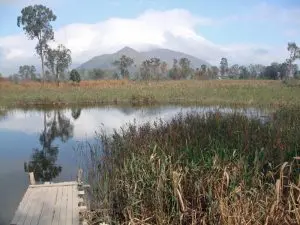



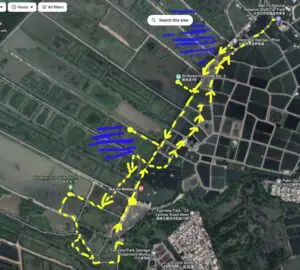
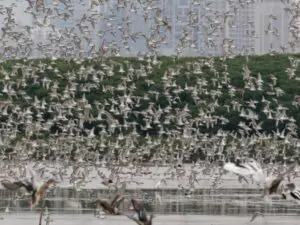

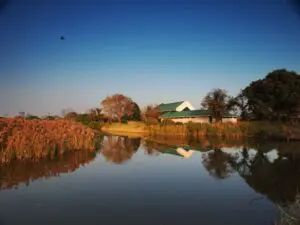


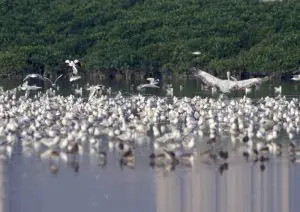



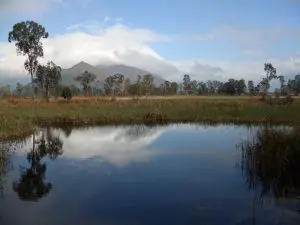




An article in Wen Wei Po advocates developing the technopole on higher ground, avoiding the San Tin fish ponds.
A translation of a paragraph to English:
//From the perspective of land use and administration, compared with the original plan, Dr. Zhang’s plan can use resources more effectively in terms of cost, operational resilience, environmental disputes and collective transportation.//
Article here: https://www.wenweipo.com/a/202411/15/AP67365a9ae4b07d24342472b2.html